Related Research Articles
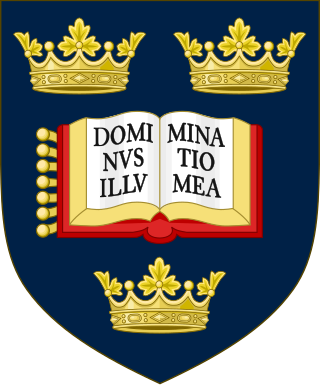
The University of Oxford is a collegiate research university in Oxford, England. There is evidence of teaching as early as 1096, making it the oldest university in the English-speaking world and the world's second-oldest university in continuous operation. It grew rapidly from 1167, when Henry II banned English students from attending the University of Paris. After disputes between students and Oxford townsfolk, some Oxford academics fled northeast to Cambridge, where, in 1209, they established the University of Cambridge. The two English ancient universities share many common features and are jointly referred to as Oxbridge.

Somerville College, a constituent college of the University of Oxford in England, was founded in 1879 as Somerville Hall, one of its first two women's colleges. Among its alumnae have been Margaret Thatcher, Indira Gandhi, Dorothy Hodgkin, Iris Murdoch, Philippa Foot, Vera Brittain and Dorothy L. Sayers. It began admitting men in 1994. Its library is one of Oxford's largest college libraries. The college's liberal tone derives from its founding by social liberals, as Oxford's first non-denominational college for women, unlike the Anglican Lady Margaret Hall, the other to open that year. In 1964, it was among the first to cease locking up at night to stop students staying out late. No gowns are worn at formal halls.

Lady Margaret Hall (LMH) is one of the constituent colleges of the University of Oxford in England, located on a bank of the River Cherwell at Norham Gardens in north Oxford and adjacent to the University Parks. The college is more formally known under its current royal charter as "The Principal and Fellows of the College of the Lady Margaret in the University of Oxford".
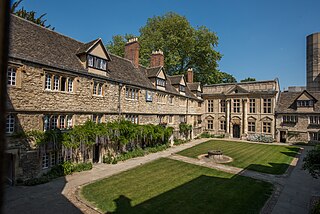
St Edmund Hall is a constituent college of the University of Oxford. The college claims to be "the oldest surviving academic society to house and educate undergraduates in any university" and was the last surviving medieval academic hall at the university.
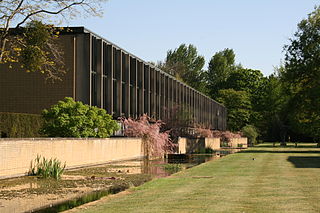
St Catherine's College is one of the constituent colleges of the University of Oxford. In 1974, it was also one of the first men's colleges to admit women. It has 528 undergraduate students, 385 graduate students and 37 visiting students as of December 2020, making it one of the largest colleges in either Oxford or Cambridge.
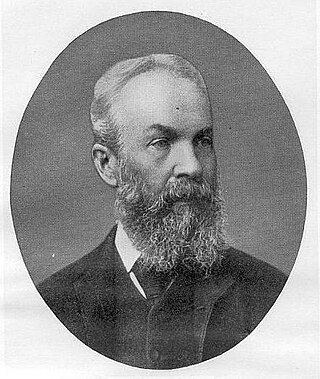
Henry Nettleship was an English classical scholar.

Dame Emily Penrose, was an ancient historian and principal of three early women's university colleges in the United Kingdom: Bedford College from 1893 until 1898, Royal Holloway College from 1898 until 1907, and Somerville College, Oxford University from 1907 until 1926. She was the first woman to achieve First Class honours in Classics at Oxford University, and was instrumental in securing the admission of women as full members of the university in 1920. She became Oxford's first Dame in 1927.

Oxford University Department for Continuing Education (OUDCE) is a department within the University of Oxford that provides continuing education mainly for part-time and mature students. It is located at Rewley House, Wellington Square, and at Ewert House, both in Oxford, England.

Edward Stuart Talbot was an Anglican bishop in the Church of England and the first Warden of Keble College, Oxford. He was successively the Bishop of Rochester, the Bishop of Southwark and the Bishop of Winchester.
"Steamboat ladies" was a nickname given to a number of female students at the women's colleges of the universities of Oxford and Cambridge who were awarded ad eundem University of Dublin degrees at Trinity College Dublin, between 1904 and 1907, at a time when their own universities refused to confer degrees upon women. The name comes from the means of transport commonly used by these women to travel to Dublin for this purpose.

Frederick Charles Plumptre (1796–1870) was a Victorian academic and administrator. He was Master of University College, Oxford for many years until the end of his life and concurrently Vice-Chancellor of Oxford University for four years.

Mary Anne Henley Rogers was a British promoter of women's education. She had an offer of a university place at the University of Oxford withdrawn when it was realised that the candidate was female. She proved that she was capable of achieving first-class Oxford University degrees but could not receive a formal degree until 1920. Her work as a home tutor for women students led to her being recognised as a founder of St Anne's College, Oxford. She wrote a history of the admission of women to Oxford University and its degrees, which was published posthumously.
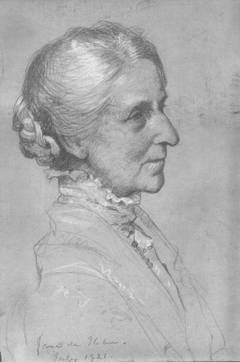
Bertha Jane Johnson, was the principal of the Society of Oxford Home-Students, which would become St Anne's College, University of Oxford, and a campaigner for women's education.

Charlotte Byron Green born Charlotte Byron Symonds was a British promoter of women's education. She supported Somerville College from its foundation.

Hon. Lavinia Lyttelton was a British promoter of women's education in the United Kingdom.
The academic halls were educational institutions within the University of Oxford. The principal difference between a college and a hall was that whereas the former are governed by the fellows of the college, the halls were governed by their principals. Of over a hundred halls in the Middle Ages, only St Edmund Hall survived into the mid-20th century, becoming a college in 1957.
The private halls of the University of Oxford were educational institutions within the University. They were introduced by the statute De aulis privatis in 1855 to provide a less expensive alternative to the colleges and academic halls of the early nineteenth century. They survived until 1918, when the last two private halls were recognised as permanent private halls.

In 1920, the University of Oxford admitted women to degrees for the first time during the Michaelmas term. The conferrals took place at the Sheldonian Theatre on 14 October, 26 October, 29 October, 30 October and 13 November. That same year, on 7 October, women also became eligible for admission as full members of the university.
The Delegacy for Women Students was a committee formed by the University of Oxford which oversaw the governance of Oxford's women students and colleges. It marked the first time Oxford officially recognised the existence of women students.
References
- 1 2 Brockliss 2016, p. 373.
- ↑ Loader, Helen (2019). Mrs Humphry Ward and Greenian Philosophy: Religion, Society and Politics. Palgrave Macmillan. pp. 84–85. ISBN 9783030141110.
- ↑ Sutherland, John (1990). Mrs. Humphry Ward: Eminent Victorian, Pre-eminent Edwardian. Oxford University Press. pp. 63–64. ISBN 9780198185871. OL 1878534M.
- ↑ "Talbot [née Lyttelton], Lavinia (1849–1939), promoter of women's education" . Oxford Dictionary of National Biography (online ed.). Oxford University Press. 2004. doi:10.1093/ref:odnb/52031 . Retrieved 12 August 2020.(Subscription or UK public library membership required.)
- ↑ Brockliss 2016, p. 374.
- ↑ Brockliss 2016, p. 375.
- 1 2 3 4 5 Salter & Lobel 1954, pp. 351–353.
- ↑ Adams 1996, p. 33.
- ↑ Adams 1996, p. 35.
- ↑ Brock & Curthoys 2000, p. 258.
- ↑ Brock & Curthoys 2000, p. 261.
- ↑ Adams 1996, p. 51.
- ↑ Brock & Curthoys 2000, p. 247.
- ↑ Brock & Curthoys 2000, pp. 256–257.
- ↑ Brock & Curthoys 2000, p. 269.
- ↑ Jones, Duncan. "History of the Nettleship Library (I): The Early Years". St Anne's College, Oxford. Retrieved 17 August 2020.
- ↑ "A Short History of Women's Education at the University of Oxford". Faculty of History University of Oxford. Retrieved 21 January 2021.
- ↑ Schwartz, Laura (2011). A Serious Endeavour: Gender, Education and Community at St Hugh's, 1886-2011. Profile Books. p. 63. ISBN 9781846685156.
Sources
- Adams, Pauline (1996). Somerville for Women: An Oxford College, 1879-1993. Oxford University Press. ISBN 9780199201822.
- Brock, Michael G.; Curthoys, Mark C., eds. (2000). The History of the University of Oxford. Vol. 7: Nineteenth-Century part 2. Oxford University Press. ISBN 9780199510177.
- Brockliss, L.W.B. (2016). The University of Oxford: A History. Oxford University Press. doi:10.1093/acprof:oso/9780199243563.001.0001. ISBN 9780199243563.
- Salter, H. E.; Lobel, Mary D., eds. (1954). "A History of the County of Oxford: Volume 3, the University of Oxford". Victoria County History.
